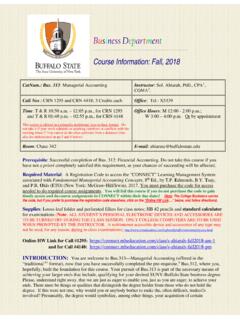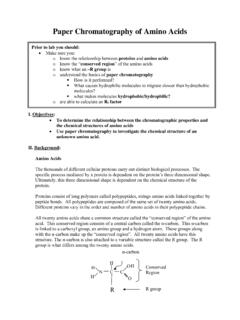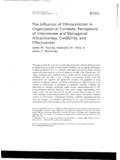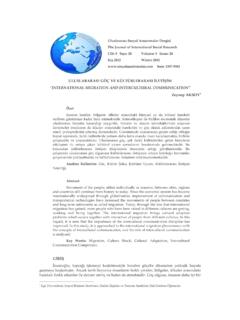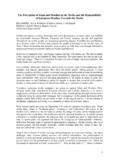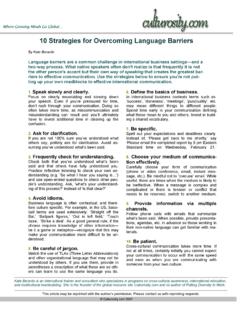Transcription of Unit 4 Intrapersonal and Interpersonal Communication
1 Unit 4 Intrapersonal and Interpersonal Communication This unit provides on overview of the various levels of Communication . It focuses on both Intrapersonal and Interpersonal levels, relating these to potential difficulties associated with conflict and misunderstood relationships. Learning Outcomes: Students who complete Unit 4 will be able to: explain the various types of intra and Interpersonal Communication discuss the role of stereotypes in the Communication process identify the role of Communication conflict in intercultural relationships Key Concepts for Unit 4. Definition and conceptualization of Intrapersonal Communication Definition and conceptualization of Interpersonal Communication and overview of categories Definition and conceptualization of stereotypes Overview of conflict and Communication Levels of Communication Scholars categorize different levels and types of Communication .
2 These distinctions are somewhat artificial, since types of Communication more realistically fit on a continuum rather than in separate categories. Nevertheless, to understand the various types of Communication , it is helpful to consider various factors. The distinguishing characteristics include the following: Number of communicators (one through many). Physical proximity of the communicators in relation to each other (close or distant). Immediacy of the exchange, whether it is taking place either (1) live or in apparently real time or (2) on a delayed basis. Number of sensory channels (including visual, auditory, tactile and so on). The context of the Communication (whether face-to-face or mediated). Note that each level of Communication may be formal or informal, personal or impersonal.
3 Note also that the purposes of Communication may vary and overlap, giving a communicator a potentially wide list of choices for Communication channels. Broadly speaking, the levels of Communication can be categorized in a four-fold pattern as Intrapersonal , direct Interpersonal , mediated Interpersonal , and mass. Unit 4. Intrapersonal and Interpersonal Communication Page 35. Intrapersonal Communication Intrapersonal Communication takes place within a single person, often for the purpose of clarifying ideas or analyzing a situation. Other times, Intrapersonal Communication is undertaken in order to reflect upon or appreciate something. Three aspects of Intrapersonal Communication are self- concept, perception and expectation. Self-concept is the basis for Intrapersonal Communication , because it determines how a persona sees him/herself and is oriented toward others.
4 Self-concept (also called self-awareness) involves three factors: beliefs, values and attitudes. Beliefs are basic personal orientation toward what is true or false, good or bad; beliefs can be descriptive or prescriptive. Values are deep-seated orientations and ideals, generally based on and consistent with beliefs, about right and wrong ideas and actions. Attitudes are learned predisposition toward or against a topic, ideals that stem from and generally are consistent with values. Attitudes often are global, typically emotional. Beliefs, values and attitudes all influence behavior, which can be either spoken opinion or physical action. Some psychologists include body image as an aspect of Intrapersonal Communication , in that body image is a way of perceiving ourselves, positively or negatively, according to the social standards of our culture.
5 Other things that can affect self-concept are personal attributes, talents, social role, even birth order. Whereas self-concept focuses internally, perception looks outward. Perception of the outside world also is rooted in beliefs, values and attitudes. It is so closely intertwined with self-concept that one feeds off the other, creating a harmonious understanding of both oneself and one's world. Meanwhile, expectations are future-oriented messages dealing with long-term roles, sometimes called life scripts. These sometimes are projections of learned relationships within the family or society. Intrapersonal Communication may involve different levels of Communication activity: internal discourse, solo vocal Communication , and solo written Communication .
6 Internal discourse involves thinking, concentration and analysis. Psychologists include both daydreaming and nocturnal dreaming in this category. Prayer, contemplation and meditation also are part of this category, though from a theological point of view the argument may be made that this is not solely internal to one person. In Sufi tradition, this is similar to the concept of nafs, negotiating with the inner self. Example: Consciously appreciating the beauty of a sunset. Solo vocal Communication includes speaking aloud to oneself. This may be done to clarify thinking, to rehearse a message intended for others, or simply to let off steam. Example: Talking to yourself as you complain about your boss. Solo written Communication deals with writing not intended for others.
7 Example: An entry in a diary or personal journal. Direct Interpersonal Communication Direct Interpersonal Communication involves a direct face-to-face relationship between the sender and receiver of a message, who are in an interdependent relationship. Because of Interpersonal Communication 's immediacy (it is taking place now) and primacy (it is taking place here), it is Unit 4. Intrapersonal and Interpersonal Communication Page 36. characterized by a strong feedback component. Communication is enhanced when the relationship exists over a long period of time. Interpersonal Communication involves not only the words used but also the various elements of nonverbal Communication . The purposes of Interpersonal Communication are to influence, help and discover, as well as to share and play together.
8 Interpersonal Communication can be categorized by the number of participants. Dyadic Communication involves two people. Example: Two friends talking. Group Communication involves three or more persons, though Communication scholars are inconsistent as to the top end of the number scale. The smaller the number in the group, the more closely this mode resembles Interpersonal Communication . Often group Communication is done for the purpose of problem solving or decision making. Example: University study group. Public Communication involves a large group with a primarily one-way monologue style generating only minimal feedback. Information sharing, entertainment and persuasion are common purposes of public Communication . Example: Lecture in university class.
9 Another way of categorizing Interpersonal Communication is on the function or setting of the Communication . Organizational Communication deals with Communication within large organizations such as businesses. This is sometimes considered part of group Communication , but Communication scholars have built up a body of knowledge focused primarily on organizations. Example: Work- focused discussion between employer and employee. Family Communication focuses on Communication patterns within nuclear, extended and blended families. Like organizational Communication , this too is sometimes seen as part of the general category of group Communication , but much research has been focused specifically on Communication within a family relationship. Family Communication can be enhanced by the long-standing and close relationships among participants as well as the likelihood that families have shared heritage, similar values, and social rituals.
10 Patterns differ in Communication between spouses, between parent and child, among siblings, and within the wider family context. Example: Conversation during a holiday meal. Additionally, some scholars identify a category of impersonal Communication . This is a distinction between impersonal and Interpersonal Communication on the basis of the quality of the interaction. Impersonal Communication is that which involves functional short-term exchanges such as might occur between a shopper and a salesman; the label of Interpersonal is reserved for Communication that functions in deeper and more meaningful relationships. The process of Interpersonal Communication includes several stages over an extended life cycle. Communication scholar Mark Knapp has outlined one useful framework for understanding the coming-together process.


